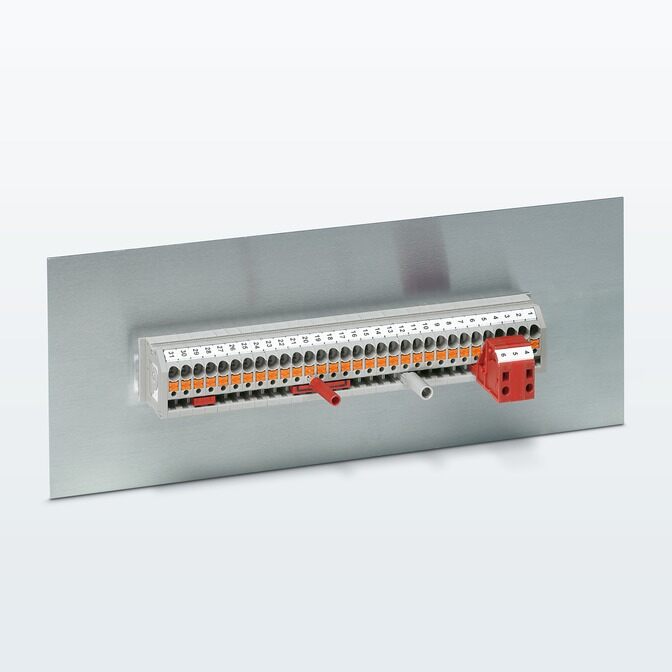- Home
- About
- Products
- Product Testing
- Application
- Services
- Information
- Contact
Views: 2468 Author: Site Editor Publish Time: 2021-04-05 Origin: Site

The terminal looks simple, but the it also needs to undergo rigorous product verification tests and periodic production type experiments. Today, we will introduce the content, methods and judgment standards of the mechanical, electrical and environmental performance tests of the terminal.
The purpose of the tightening torque test is to test whether the screw has sufficient mechanical strength to ensure that no slipping occurs during the pressing process. If the screw is not broken and deformed after the test, and there is no damage to the screw head groove that affects continued use, the screw is qualified.
The purpose of the secureness test is to test whether the terminal can clamp the wire without undue damage to the wire. We use the terminal to connect the wires of the specified type and rated cross-sectional area, hang a certain weight, and rotate at a speed of 10 revolutions per minute (1012r / min) for 15 minutes. After testing, the crimping reliability of the terminal is acceptable if the wire does not slide out of the terminal clamp or break near the clamp. If the clamping mechanism of the wire breaks or falls out of the terminal, it is unqualified.
The purpose of the pull out test is to test whether the terminal can hold the wire firmly between the metal surfaces. We use the terminal to connect the conductor of the specified type and rated cross-sectional area, and then use a certain force to pull the conductor toward the axis of the conductor for 1 minute. It is acceptable if the wire does not come out of the terminal.
The purpose of the mechanical strength test is to test whether the terminal has sufficient mechanical strength, especially to test whether the housing of the terminal has sufficient mechanical strength. During the test, we put the sample into the drum of the test equipment and rotate it at 5 revolutions per minute for 5 minutes. Then we shut down and take out the sample for observation. It is acceptable if the terminal is not damaged and the case is free of cracks and damage.
The purpose of the fatigue test is to test whether the elastic components of the terminal can withstand a certain number of insertions and withdrawals or other mechanical operations, such as the compression and release of spring-type terminal buttons. If the tested elastic element is fitted into the terminal and the mechanical and electrical properties still meet the requirements, it is acceptable.
The contact resistance test is to test the static contact performance of the terminal. The contact resistance should not be greater than a certain value.
The power-frequency withstand voltage test is to test whether the terminal housing can withstand the specified transient or short-term power frequency overvoltage. During the test, no flashover or breakdown shall occur.
The mpulse withstand voltage test tests whether the terminal housing can withstand the specified transient overvoltage. There shall be no destructive discharge during the test.
The voltage drop test is a test of the dynamic contact performance of the terminals. The voltage drop should not be greater than a certain value.
The temperature rise test is to test whether the terminal exceeds the specified value during normal use. The general UL standard stipulates that after the terminal passes the current, its temperature rise cannot exceed 30 ° C of the ambient temperature.
The electrical performance test is used to test the reliability of the electrical performance of screwless terminals in normal use. After the terminal has undergone 192 cycles, its voltage drop during the 24th and last cycle must not be greater than a certain value.
3. Environmental Performance Test
This test simulates the ability of a terminal package to withstand vibration during transportation. After testing, the terminals in the package must not be affected or damaged.
This test is to simulate the ability of the terminal to withstand vibration during use. The front, rear, left and right, and top and bottom of the terminal are sequentially fixed on the vibration table, and a predetermined analog quantity is applied to the X, Y, and Z axis directions of the terminal. After testing, the terminals must not be damaged.
This test is to test the flame retardancy of the terminal material. During the test, the standard spline is clamped to the clamp holder of the instrument test. We move the ignition source to the prescribed position for ignition, and then remove the ignition source after the prescribed time. If the sample strip still burns after the fire source is removed or its drips ignite the cotton under the sample strip, the flame retardancy is unacceptable. If the sample strip extinguishes itself after the fire source is removed, the flame retardance is acceptable.
This test is to test whether the terminal can be used normally at a certain high temperature. The terminal is placed in an aging test box, and a high temperature of 105'C or 120 ° C is applied for 7 days. If the terminal under test does not age, it is qualified.
These two tests test whether the terminal can withstand the humid conditions that may occur during normal use. After conducting a separate test on the metal parts of the terminal, if the metal parts are corroded, they are unqualified.
That's all for the terminal performance test.